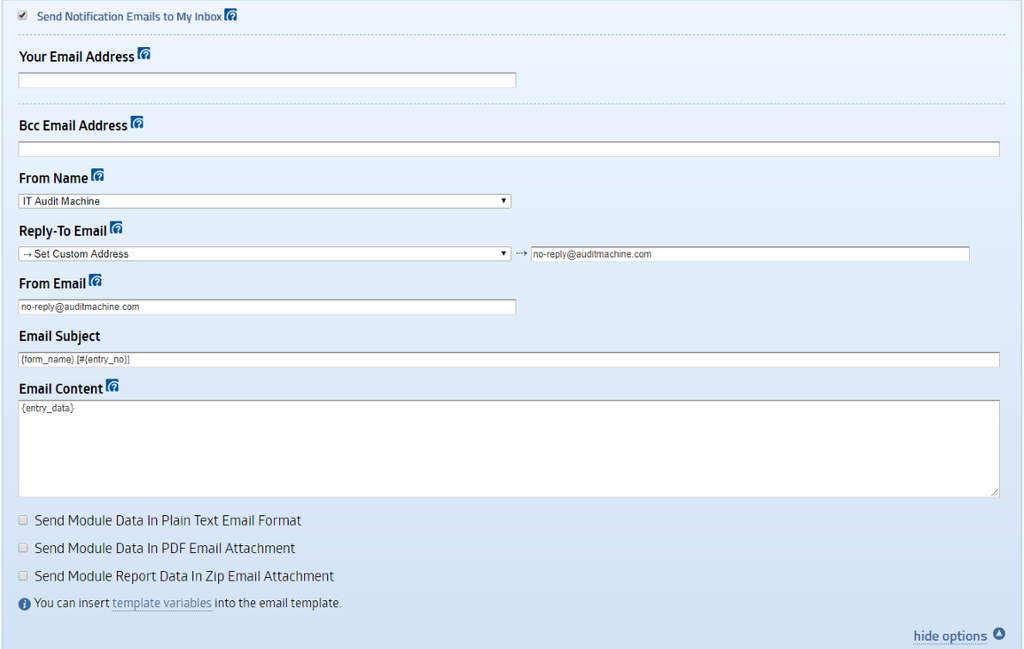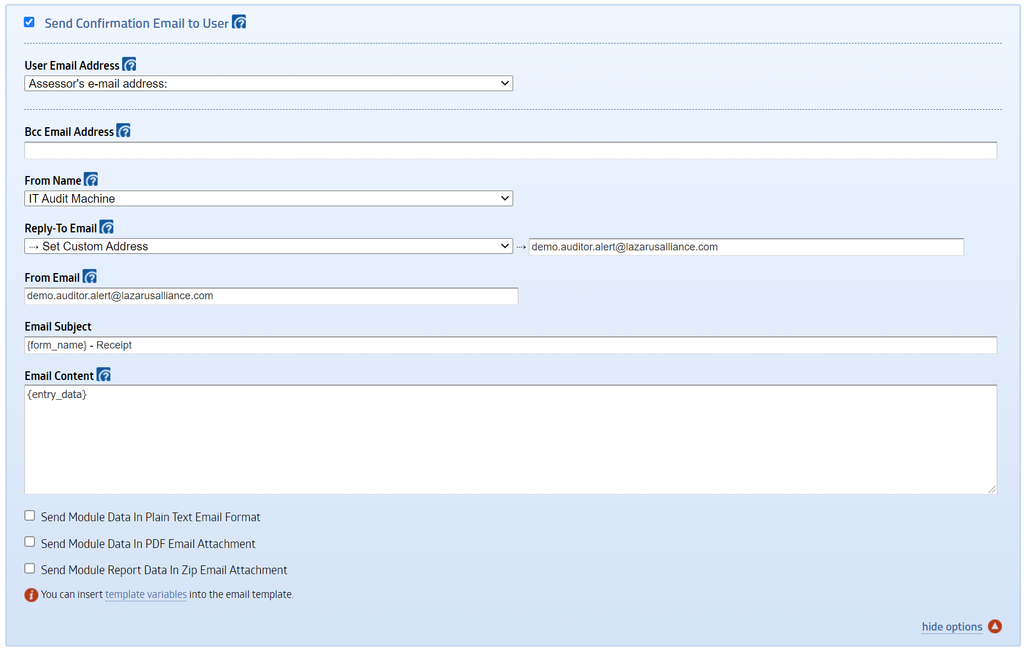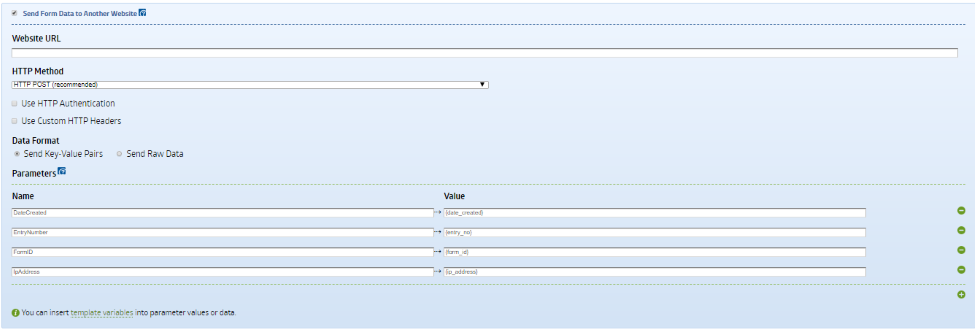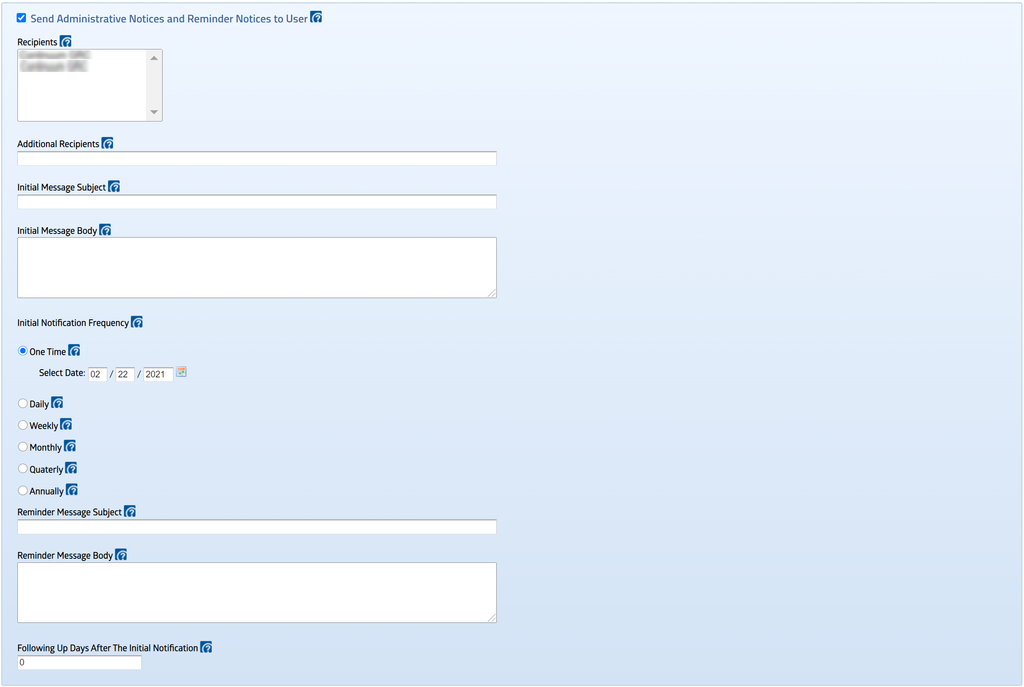Form Notifications
Table of Contents
ToggleOverview
One of the challenges in documenting compliance with a standard is keeping the process moving forward and everyone updated on the effort's progress. ITAM was designed with a powerful notification engine to handle that very need. Each form created in ITAM allows form-specific email notifications and confirmations to be sent at various times during the process. You can use the default email format or customize several email notification parameters to adapt it to your organization’s needs.
On this guide page, we’ll cover Form Notifications, an aspect of Advanced Form Management vital for effective communication while filling out a form. ITAM supports four (4) different types of notifications:
- Notification of form submission (Send Notification Emails to My Inbox)
- Confirmation to user after form submission (Send Confirmation Email to User)
- Send submission data to an alternate site (Send Form Data to Another Website)
- Send user reminders and notifications (Send Administrative Notices and Reminder Notices to User)
Accessing Email Notifications
The notifications button/tab below a form Manager form allows users to access a form's email notification settings.
Regardless of the form you are working on, the Notification options are the same and only applicable to that form, giving you a powerful feature to manage how information notification flows are controlled.
Notification Settings Interface
The notification settings interface is where you find the four (4) notification options. The first option is available to define an email notification to one or more interested parties, typically the form’s designer or administrator, that a submission has occurred. The second option is available to define an auto-responder type email notification to the user who completes and successfully submits the form. The third option allows sending the form data to any other custom URL. The fourth option sends administrative notices to users based on a schedule.
Selecting any notification option expands that section to display some default configuration options. In some cases, a "more options" link is provided at the bottom of the form, which, when clicked, reveals additional customization options.
Customizing the Basic Email Options
Most of the email configuration fields should be familiar to email users. Clicking and hovering over the green question mark icon adjacent to each option will display additional help. However, several specific features are described further below.
Customizing the Subject and Content
The Email Subject and the Email Content fields of the email notification options are fully customizable using text, HTML code, and CSS. There is also the option to add template variables. These are accessed using the template variables link at the bottom of the fields. Template variables include data from the form in the notification and appear as a field name surrounded by curly braces ( i.e. {field_name} ). Don’t worry, you don’t have to know the template variable field names for each field yourself, the template variable link will pop up a Template Variable Lookup tool that can be used to add the fields you need to your notification.
Send Notification Emails to My Inbox
Enable this option to send a receipt copy of the submission to the designated administrator or manager of the specific form, questionnaire, or module. Only the Email Address is required, as the fields are initially configured to send a default message. However, using the More Options link at the bottom of the initial form displayed, you can expose additional options for further configuration.
A few special options you may select are:
|
Option |
Description |
|---|---|
|
Send Module Data In Plain Text Email Format |
This option includes a text version of the module's data submission in a prepared email message to all recipients listed. |
|
Send Module Data In PDF Email Attachment |
This option includes a PDF version of the module's data submission in a prepared email message to all recipients listed. |
|
Send Module Report Data In Zip Email Attachment |
This option attaches the module's template output as a Zip file attachment in a prepared email message to all recipients listed. |
Send a Confirmation Email to the User
If you want your users to receive a copy of their submission as a receipt copy when they submit a form, the “Send Confirmation Email to User” option is designed for just that requirement.
If the form in question has an email field type, it will be presented as an option for sending the email.
If the form does not have email fields, the system will notify you that an email field is required, and you will be unable to customize the notification type until you have that option in the form.
Similar to the Notification Emails for Administrative Users, a default email can be sent with no additional configuration other than the Email Address; however, additional configuration options are available and accessed by clicking the more options link at the bottom right of the form.
A few special options you may select are:
|
Option |
Description |
|---|---|
|
Send Module Data In Plain Text Email Format |
This option includes a text version of the module's data submission in a prepared email message to all recipients listed. |
|
Send Module Data In PDF Email Attachment |
This option includes a PDF version of the module's data submission in a prepared email message to all recipients listed. |
|
Send Module Report Data In Zip Email Attachment |
This option attaches the module's template output as a Zip file attachment in a prepared email message to all recipients listed. |
Send Form Data to Another Website
In some advanced cases, your organization may have another web-enabled tool to receive and process the data from an ITAM form. The “Send Form Data to Another Website” option is where you can configure this type of integration. This is useful for integrating ITAM-captured form data with other web applications such as Continuum GRC, MailChimp, Salesforce, Basecamp, etc.
The options available are listed in the following table:
|
Option |
Description |
|---|---|
|
Website URL |
Place the URL of your integration application here. |
|
HTTP Method |
This lets you choose between the HTTP Get, HTTP Put, and HTTP Post (recommended) integration methods. Warning: HTTP GET is not recommended for transferring data. It is included as an option as that is the only method available to some users.
|
|
Use HTTP Authentication |
If your integration application requires authentication, then choose this option. |
|
HTTP User Name |
If your integration application requires authentication, then enter the account that will be used. |
|
HTTP Password |
If your integration application requires authentication, then enter the password that will be used. |
|
Use Custom HTTP Headers |
If you need to send custom headers to your integration application, choose this option. |
|
HTTP Headers |
A JSON object of all HTTP Headers you need to send. When first enabled, the field will display some existing headers as name-value pairs in JSON format. You can add your headers and values to the list. Make sure you separate each pair with a comma. |
|
Data Format |
This option lets you be very specific with the data elements you integrate with your external web application. |
|
Send Key-Value Pairs |
These are predefined data elements. |
|
Send Raw Data |
Enter any content you would like to send here. You can use any data format (e.g. JSON, XML, or raw text). Just make sure to set the proper 'Content-Type' HTTP header. |
|
Parameters |
|
|
This option enables you to specifically identify those data elements you want to integrate with your external web application. |
|
|
Name |
You can type any parameter name you prefer here. |
|
Value |
This parameter should be the template variable of the field you would like to send. Such as {element_1} or {element_2}, etc. You can also enter any static value you may have used. |
Send Administrative Notices and Reminder Notices to User
Completing a form in ITAM, especially compliance-related forms, often involves tracking down paperwork or Subject Matter Experts (SMEs) to identify the correct data needed on a form. Sending reminders is one of the best ways to keep the effort at the forefront of your mind and to keep the process moving forward. The “Send Administrative Notices and Reminder Notices to User” option is designed to allow you to nudge the user automatically until the form is completed.
Similar to sending a regular email message to another person or distribution group email address, the IT Audit Machine's powerful messaging system provides functionality to schedule these messages.
The options available are listed in the following table:
|
Option |
Description |
|---|---|
|
Recipient |
Select the entities to whom you are going to send notifications. |
|
Additional Recipients |
Enter the additional recipient's or group's email addresses. Simply separate them with a semicolon or comma. |
|
Initial Message Subject |
Include a meaningful subject line for your recipients, like a regular email message. This subject is used when the first email for this form is sent to an Entity. |
|
Initial Message Body |
Include a meaningful message to your recipients in the message body like a regular email message. This email body is used when the first email is sent out to an Entity for this form. |
|
Reminder Message Subject |
Include a meaningful subject line for your recipients, like a regular email message. This subject is used when reminder emails are sent to an Entity for this form. |
|
Reminder Message Body |
Include a meaningful message to your recipients in the message body, just like you would in a regular email message. This email body is used when reminder emails are sent to an Entity for this form. |
|
Following Up Days After The Initial Notification |
Enter the number of days the system will wait before sending out a follow-up notification. |
|
Notification Frequency |
|
|
The Notification Frequency section allows you to determine the schedule by which your administrative notice will be sent. |
|
|
One Time |
The One Time option is used when you want to send an Administrative Notice to your recipients just once. You will select the date the action will occur. |
|
Daily |
The Daily option is used when you want to send an Administrative Notice to your recipients every day. |
|
Weekly |
The Weekly option is used when you want to send an Administrative Notice to your recipients once a week. You will select the day of the week the action will occur. |
|
Monthly |
The Monthly option is used when you want to send an Administrative Notice to your recipients every month. You will select the date (day of the month) for the action. |
|
Quarterly |
The Quarterly option is used when you want to send an Administrative Notice to your recipients every quarter. You will select the action's start month and date (day of the month). |
|
Annual |
The Annual option is used when you want to send an Administrative Notice to your recipients just once a year. You will select the date (day of the month) and month for the action. |
|
Include form URL |
The form URL will be included in the Administrative Notice message. Please remember that a recipient will most likely be required to log into ITAM to open it up for information security purposes. |





